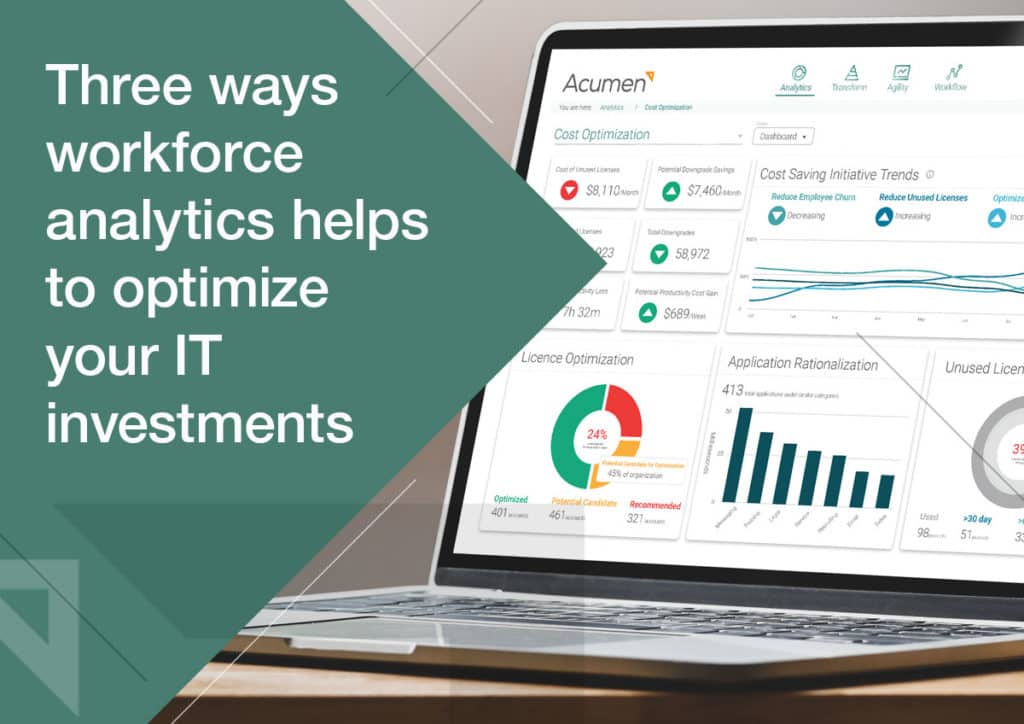Three Ways Workforce Analytics Helps to Optimize Your IT Investments
-
October 13, 2021
- Posted by: Pete Summers

Today, many organizations are racing to build hybrid working models that allow teams to work seamlessly at home or in the office. Organizations are investing heavily in digital technology, with Gartner forecasting worldwide IT spending to total $4.2 trillion this year. It’s easy to get caught up and splurge on new technology that promises incredible hybrid working experiences. However, IT leaders must keep sight of what really matters when it comes to investments: What hardware and software does your organization actually need? What is being used or not used? What is adding value?
Consolidating software contracts and renegotiating terms based on usage is commonplace to reduce IT costs and is quantifiable with established ITAM and ITSM approaches. But in a hybrid working world, managing IT spend is becoming increasingly complex. Hybrid working brings a distributed workforce, new working patterns, increased adoption of cloud, and more BYOD – all outside the four walls of the office. In this new world of work, a more sophisticated way of measuring ROI is needed. Traditional ITAM/ITSM methods alone can no longer cut it. This is where workforce analytics come in.
Here are three ways workforce analytics can help your organization optimize IT investments:
1. Make wise IT investment decisions, driven by data
Existing ITAM and ITSM approaches allow IT to assess what software and hardware exists within the business and how it is performing. However, incorporating workforce analytics into the spending review process allows for a far more nuanced assessment of IT investments.
Insights from workforce analytics mean organizations pay only for what they need and can easily rightsize entitlements and limit category sprawl. But they can also go further and more accurately infer value from their investments and better quantify the peripheral benefits of digitalization – using data on adoption and feature utilization. Further, this helps to identify gaps in services against the requirements of the business and employees. Combining these sources of data through workforce analytics allows IT leaders to make data-driven decisions that optimize investments.
2. Drive and measure digital adoption
Once IT leaders have made data-driven decisions, they need to be implemented. That involves ensuring new products or standards are adopted across the organization and that old technology is retired. Driving digital adoption in this way is key to optimizing investments and validating success in a post-deployment environment. This requires a sophisticated outlook on monitoring and measurement – particularly with a distributed, hybrid workforce.
Workforce analytics combined with specific and customizable digital KPIs helps to align technology with employee needs and calculate the business value of technology programs. The digital-first hybrid world of today needs new digital KPIs to match. IT teams must benchmark and establish the KPIs that accurately evaluate the ROI of their digital initiatives – KPIs that help you determine which parts of your organization are leading the way in adopting new technology and those parts that need more support in transitioning. For example, a Collaboration Streamlining KPI that helps you to understand not only adoption of collaboration platforms, but also helps you see how the collaboration platform is helping to make your organization’s meetings and communication more efficient over time.
3. Find inefficiencies in employee journeys
Workforce analytics enables IT teams to map out employee journeys in detail, enabling them to root out inefficiencies, and spot wasteful processes and blockers to productivity. For instance, an application may be repeatedly crashing and slowing down work, or there may be a lot of application switching due to missing application functionality or training gaps. All of those wasted minutes soon add up to many hours, and lost time is also lost money.
Using workforce analytics, organizations can pinpoint exactly where and why time is being lost and address it. This helps firstly to identify staff who might require more training on the technologies available to them. It also helps to reduce user frustration by ensuring employees working on common processes have the correct access, the correct products and the correct product versions.
Enter Acumen
Scalable Software’s Workforce Analytics platform, Acumen, collates and distills data from all technology infrastructure. It overlays the organizational context that is required to provide IT management with the insights to optimize investments and cut inefficiencies.
Acumen measures the use of your organization’s systems and technology investments. It establishes targeted KPIs that provide business leaders with a business lens through which to view technology data. This gives leaders the ability to generate insights that enable organizations to realize a higher return on digital investments.
Learn more about optimizing IT investments, and find out more about how Acumen can help your organization.